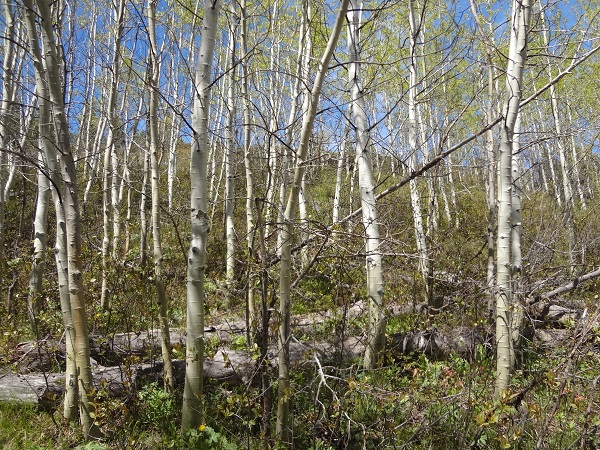Upon returning to Jackson Hole from a week in Yellowstone with the graduate students, we all noticed that our home is much greener than when we left. The grass in the Elk Refuge looks like green velvet as we descend into town. We can easily see the yellow willow branches readying to leaf-out, and the aspen announce the coming of spring with their vibrant green leaves. What causes trees to recognize spring and break-bud differs by species, but is typically a combination of a long winter chill, warming spring temperatures, and increased day length (photoperiod).
One particular tree that was leafless when we left, but is flush with small green leaves now is the quaking aspen (Populus tremuloides). Before the leaves emerge, the aspen trees flower. Many people may not recognize the hanging aspen catkins as flowers, but the fuzzy pendants are comprised of tens of tiny flowers attached to a central stem. Most flowers with which we are familiar are ‘perfect’ flowers because they have both male and female parts (stamen and pistil, respectively), but aspen flowers are imperfect, containing only male or female parts. In fact, aspen trees are dioecious, meaning they are either male or female trees. Male trees flower first, and dropped their male catkins around mid-April this year in Jackson Hole. The female trees flowered after the males and developed their catkins here in late April and early May. Pollen from the male flowers is blown by the wind to pollinate the female flowers, which then develop seeds in small green capsules that will mature and release very small seeds encased in cottony threads to aid in wind dispersal.
Most reproduction in aspen is asexual, through which new stems sprout from underground lateral roots from neighboring trees. In this way, aspen stands can be a single clone — what look like individual trees are actually various stems (or ramets) of the same organism connected by underground roots. These clones can be differentiated definitively by genetic techniques, but the keen observer may be able to tell one clone from another by subtle differences in leaf shape or synchronized foliage changes in the fall.
From the ashes of wildfire life emerges.
Historically, most scientists assumed that regeneration from seed in aspen was exceedingly rare and happened only every few thousand years when conditions were just right. But recent research has shown that aspen seedlings (plants that come from the germination of a seed rather than sprouting from a pre-existing root) are more common than has been assumed. Though, naturally occurring aspen seedlings have only been observed after severe disturbance like a severe fire or forest clearcut — as these areas can have little competition from other plants, ample sunlight, and sustained soil moisture which are all essential for successful aspen seedling survival. In fact, thousands of aspen seedlings emerged after the severe 1988 Yellowstone fires, many of which are still thriving today.
An opportunity in the Little Horse Thief Canyon Fire?
Though the fire adjacent to the town of Jackson last fall caused great fear, town evacuations, and terribly smokey air, wildfire is critical for the long-term survival of aspen in the Rocky Mountains. Aspen stands that experience wildfire can soon thereafter sprout vigorously from underground roots protected from lethal temperatures. Wildfire also reduces competition from conifers that will outcompete aspen over time and severe fire can create the exacting requirements for aspen reproduction from seed. The Little Horse Thief Fire area may at first glance look like a dead moonscape, but will provide areas where aspen and other early pioneer species can successfully germinate. An aspen seed carried by the wind to the perfect spot could create the first stem of what could become, over many years, a new aspen stand. Though not common, these events could be very important for the future of aspen trees in this area. Any newly established seedlings will have a unique genetic makeup that could make them more resilient to a future warming climate.
With spring comes a new green to Jackson Hole, and with it, opportunities for new beginnings.


